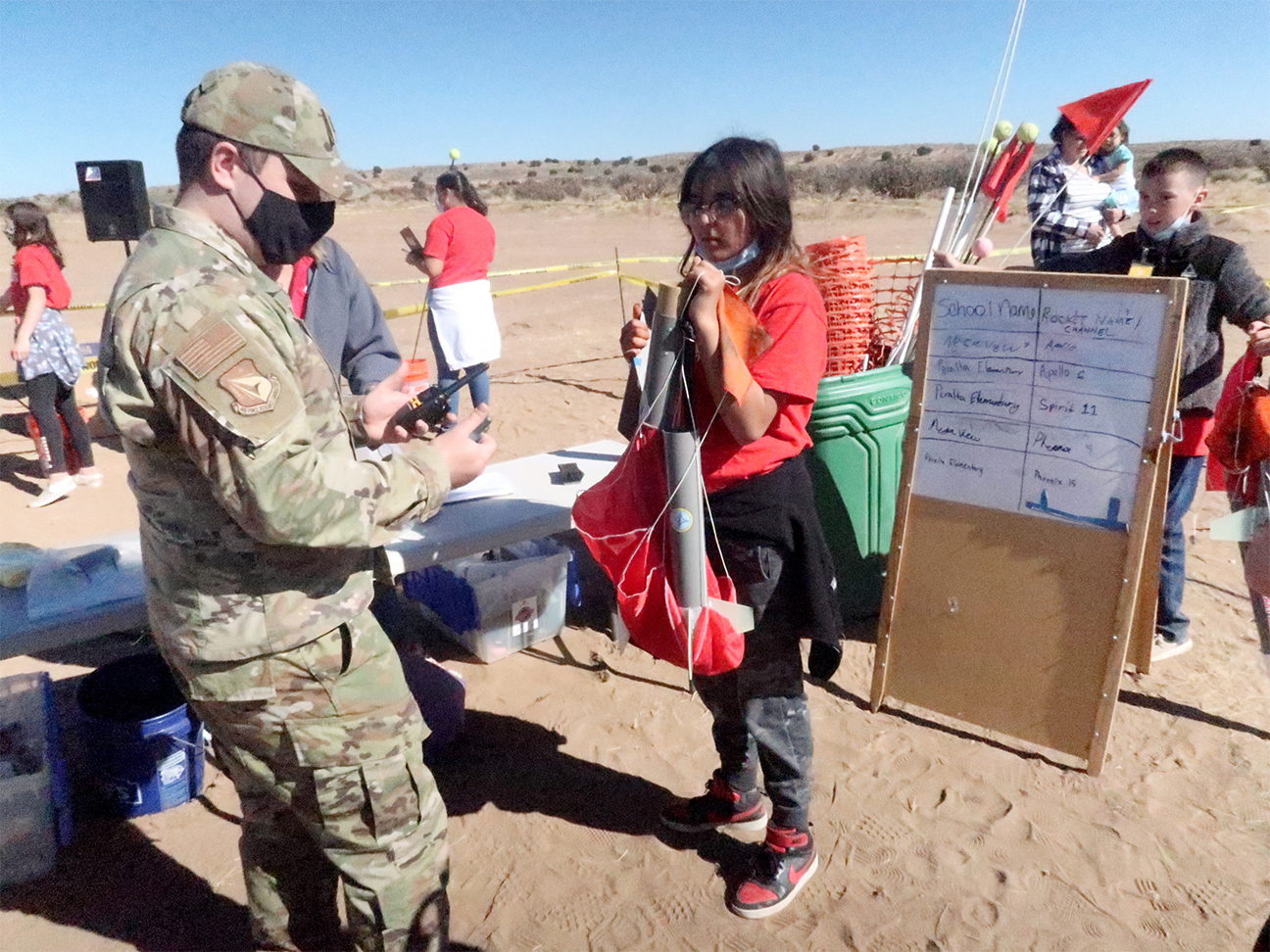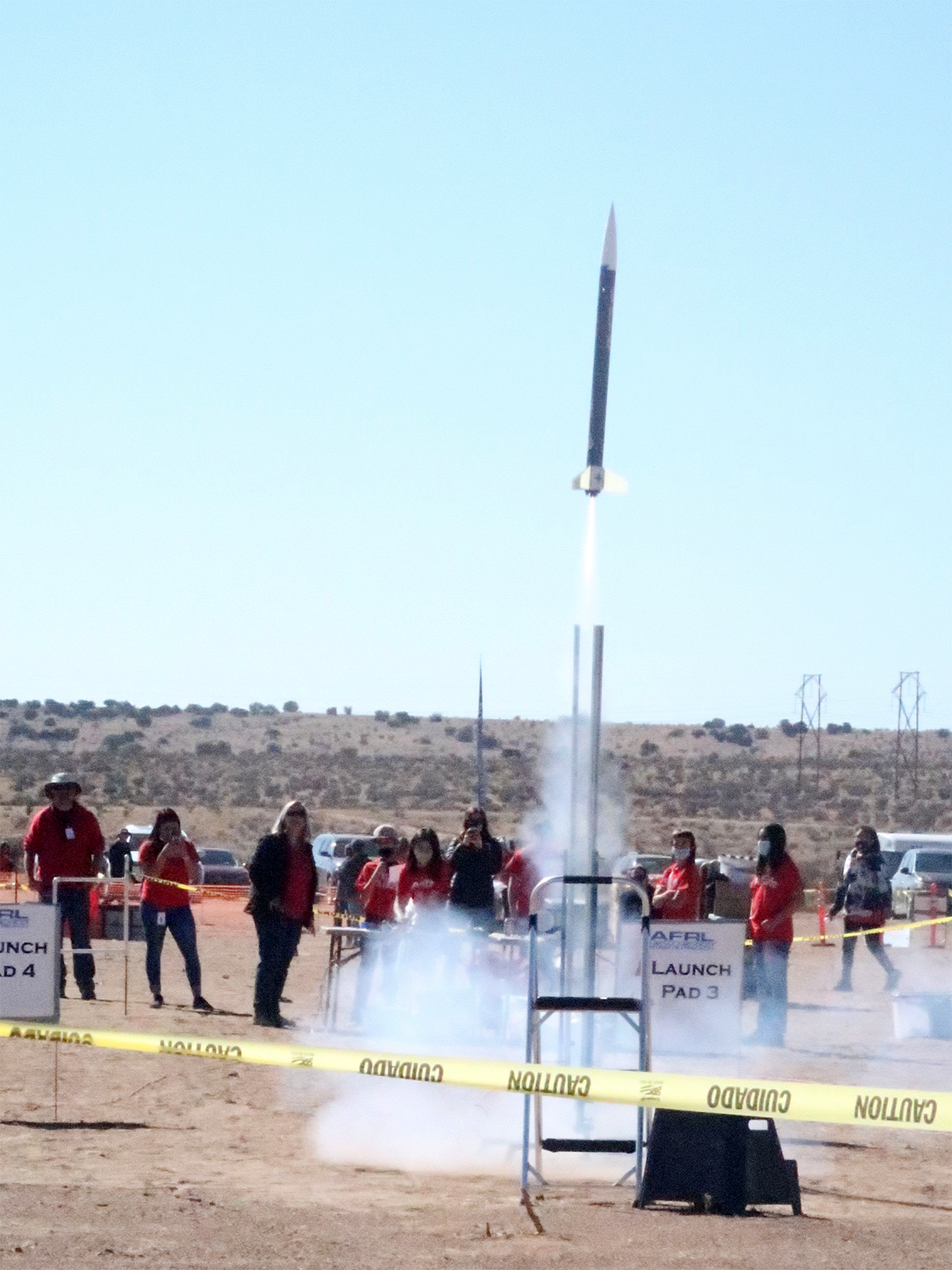AFRL celebrates successful rocket launch at STEM Academy
KIRTLAND AIR FORCE BASE, N.M. (AFRL) – “Five…four…three…two…one…launch,” the Range Safety Officer called out. The Launch Control Officer pushed the red button, and the rocket took off, whoosh! about 1,000 feet in the air.
On a beautiful sunny fall day, 184 New Mexico middle school students from Christ Lutheran, Cleveland Middle, Holy Ghost Catholic, Menaul, Mesa View Elementary, and Peralta Elementary Schools, and several home school families, went out into a field on the outskirts of Rio Rancho, and launched 20 rockets into the sky, as part of the AFRL NM STEM Academy’s annual TECH Mission Model Rocket Launch event.
“The students worked in teams and were assigned roles much like a professional rocket launch. One student served as the Launch Control Officer, one as the Range Safety Officer, one was the Data and Quality Manager, and others were assigned to the Assembly, Spotter, and Recovery teams,” said Ronda Cole Harmon, director of the AFRL STEM Academy. “They all had to complete their individual duties to successfully launch and recover their four-foot-long model rockets.”
In the weeks leading up to launch day, schools sent participating TECH Mission students to the Academy classroom facility on Kirtland Air Force Base in Albuquerque, NM to begin studying rocketry and building their rockets.
“Students learned the names and functions of various model rocket parts such as bulkhead plate, centering ring, coupler, fin, fin can wrap, nose cone, and shock cord, as they assembled the payload, motor mount, and booster tube sections of their rocket,” Harmon said. “They also chose a name for their rocket, from a list that included Apollo, Atlas, Gemini, Mercury, Opportunity, Phoenix, Saturn, and Spirit.”
In addition to building their four-foot model rocket, teams also explored modeling and simulation using a software program called RockSim. Students predicted the maximum altitude of the rockets they built and collected data showing how different wind conditions affect the launch trajectory.
On launch day, students assembled their rockets for launch, connecting a parachute and installing an altimeter. Then, Spotter and Recovery students split off from the team to prepare for their launch duties. The rest of the team installed the motor, put the rocket on the launch stand, and stood by for launch.
During the launch sequence, The Range Safety Officer checked with Meteorology to ensure wind conditions met safety requirements and verified with Spotters that the sky was clear of aircraft. After completing these safety duties, the Range Safety Officer began the countdown and the Launch Control Officer pushed the big red launch control button, sending each rocket on its trajectory.
“The rockets took about 9 seconds to reach apogee, an average altitude of about 1,063 feet,” said Harmon. “Then the rockets began free-falling back to Earth, until the ejection charge separated the payload and booster sections, releasing the parachute the students packed earlier. Time to landing was about 42 seconds after launch. The Spotter team watched the rocket closely the whole time, through binoculars, to determine roughly where the rocket landed.”
Once the range was declared safe by the Launch Director, Recovery teams retrieved the rockets, and guided their Spotter teams via walkie-talkie. After locating the rocket, the Recovery team listened to the coded beeps emitted by the altimeter, recorded the rocket’s peak altitude, and then gathered data from a GPS unit on the distance the rocket landed away from the launch pad. The teams took recovered rockets to the Disassembly table, where, with help from mentors, they removed reusable parts such as the altimeter and parachute.
“These students will return to Kirtland Air Force Base for their third and final day of the TECH Mission, where they will analyze their data and compare differences between the simulation of the rocket’s flight, and the data they collected from the actual flight,” said Harmon. “Students will also complete activities that help them learn physics concepts that connect to model rocketry and space flight.”
The TECH Mission provides meaningful STEM learning opportunities for students and educators through firsthand activities that apply STEM content to model rocketry. It also introduces participants to available career possibilities as they consider their place in the future workforce. Student recruitment focuses on students from underserved and underrepresented groups in STEM.
“Introducing students to space concepts early in their education, plants a seed that may blossom into a future career in STEM,” said Harmon. “Participation in this program allows students to see there is a place for them in STEM, perhaps even as an Airman or Guardian.”

Air Force Research Laboratory’s STEM Academy holds a rocket launch for Albuquerque area students. AFRL 1st Lt. Caleb Sapp advises a student on her team’s rocket. (U.S. Air Force photo/Stephen Burke)

Rockets blast off as, Air Force Research Laboratory’s STEM Academy holds their annual TECH Mission Rocket Model Launch, for Albuquerque area students. (U.S. Air Force photo/Stephen Burke)
